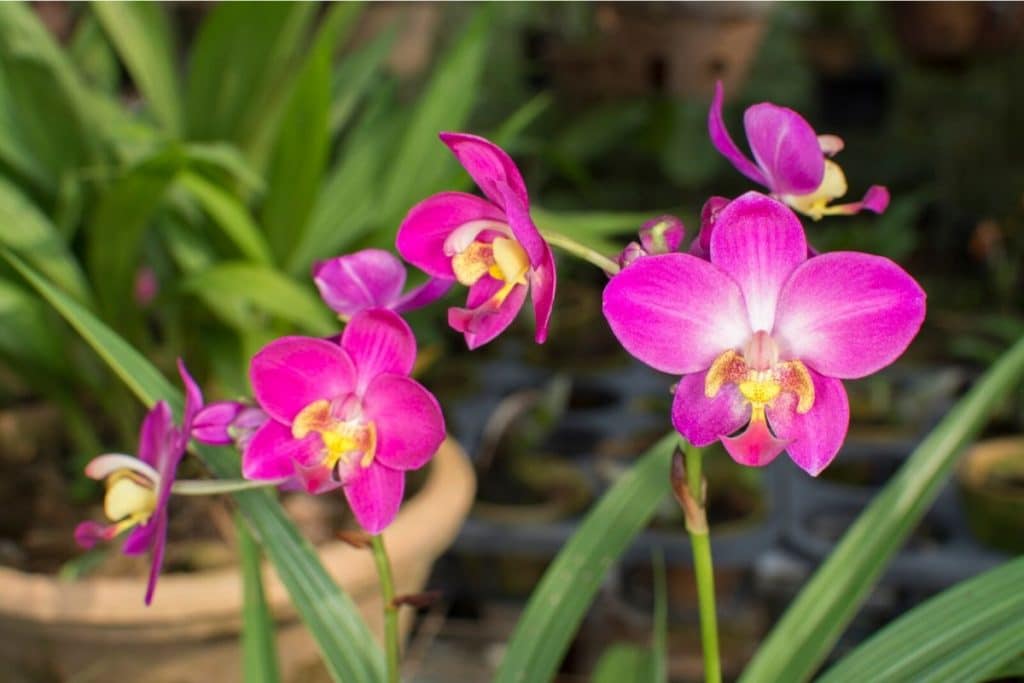With their undeniably unique yet elegant appearance, orchid flowers have quickly become one of the most recognizable ornamental plants.
Adding to their exotic beauty is their easy-to-care nature and long-lasting blooms that make these flowers popular among house plant hobbyists and gardeners all over the world.
Orchids flowers offer different types in a plethora of colors and varieties. Despite the vast choices available, one thing remains no matter which orchid type you pick – all of them are stunning.
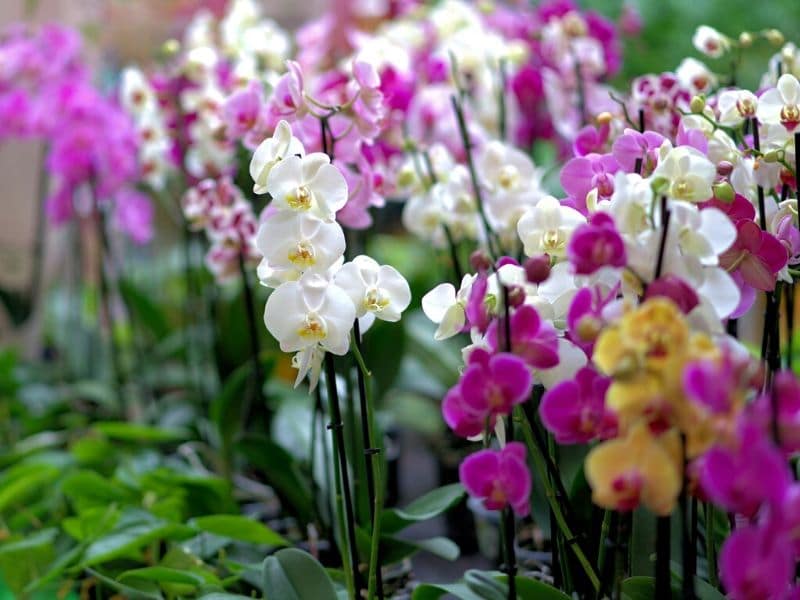
Another great point is that orchids have long-lasting blooms, which makes them the best indoor plants with long lasting flowers.
Read on to learn more about orchids, including the most popular types of orchids that you could get for your home and garden.
Orchids: An Overview
The orchids family, otherwise called Orchidaceae, is one of the largest botanical families. It contains hundreds of genera and countless species and cultivars found across the globe, except Antarctica (1).
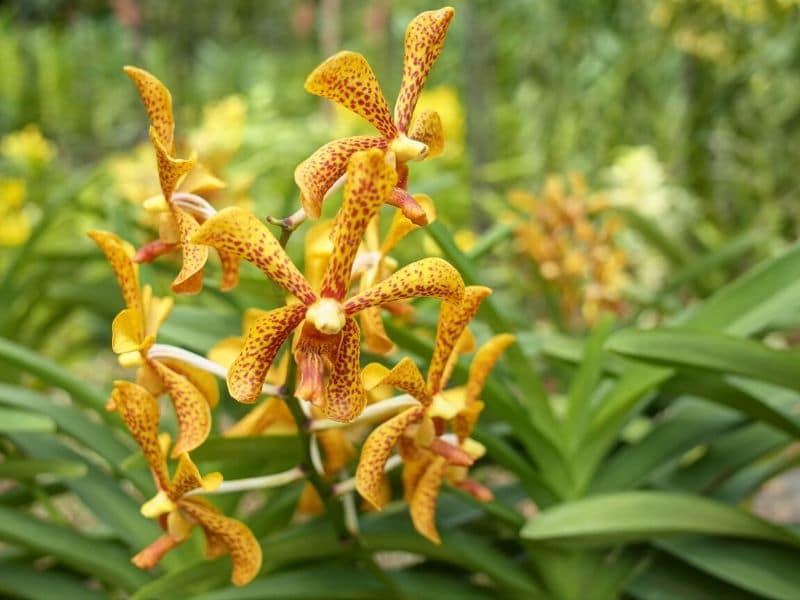
These flowering plants are well-known not only for their exquisite blooms and ornamental value. They are valued as well for their symbiotic association and horticultural importance.
Orchid flowers are some of the most beautiful flowers and are readily available in white, purple, orange, blue, red, almost black, or a combination of colors. Some species, however, also offer striped or spotted flower variations. The exquisite orchid flowers can last from a week to as long as four months, depending on the species.
Growth Habits of Orchids Plants
Orchids can be classified into two general types: epiphytic orchids and terrestrial orchids (2). Knowing the differences between these two types will provide you with a better idea of how to grow and care for these exotic beauties.
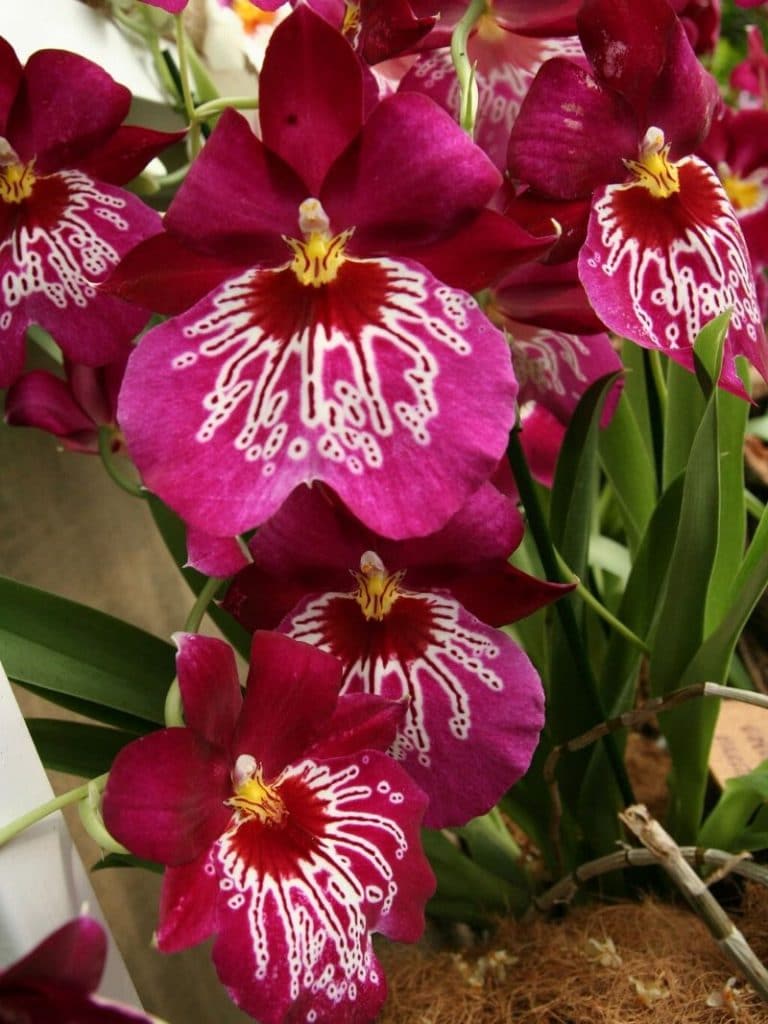
Epiphytes
Epiphytic orchids are plants from the Orchidaceae family that depend on structural support for growth (2). They grow on structures like rocks, trees, and poles. There are two groups of epiphytic orchids based on stem structure and growth habit: sympodial and monopodial (3).
Its horizontal growth habit characterizes a sympodial orchid. This type of epiphytic orchid often features pseudobulbs, a thickened stem from which the leaves emerge, that are attached to a basal rhizome (3). The pseudobulbs store water and food, which allow the plant to go for a prolonged period without water until the growing medium dries out.
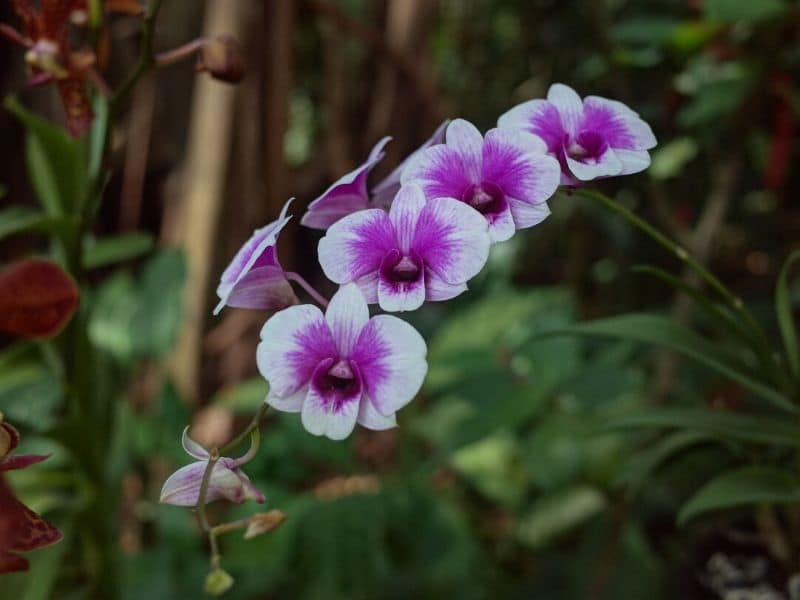
Examples of sympodial orchids include Cattleya, Oncidium, Dendrobium, and Cymbidium orchids.
On the contrary, a monopodial orchid is an epiphytic orchid that grows upright or vertically. It features side shoots, which likewise grow upright. Unlike sympodial orchids, this type of epiphyte plants does not develop pseudobulbs.
Vanda and Phalaenopsis are just two of the most common monopodial orchids.
Terrestrial
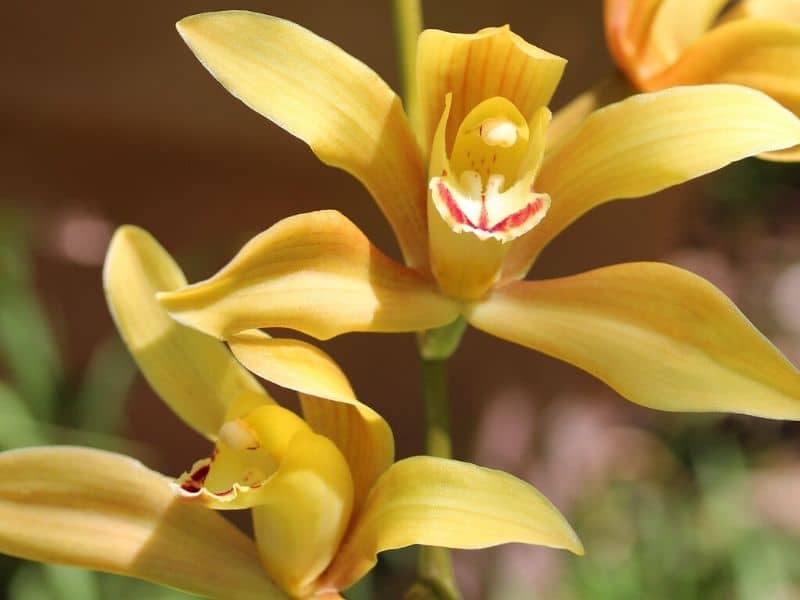
Orchids that grow in soil on the ground and do not require a host for it to survive fall under the terrestrial type. Most of these orchids prefer cold weather, with some even requiring sub-freezing temperatures to flower correctly. Terrestrial orchids are dormant during summer (2).
A semi-terrestrial orchid is the type of orchid that grows in the soil, but can also thrive well on structures. One popular example of this is Cymbidium orchids.
Structures Of Orchid Flowers
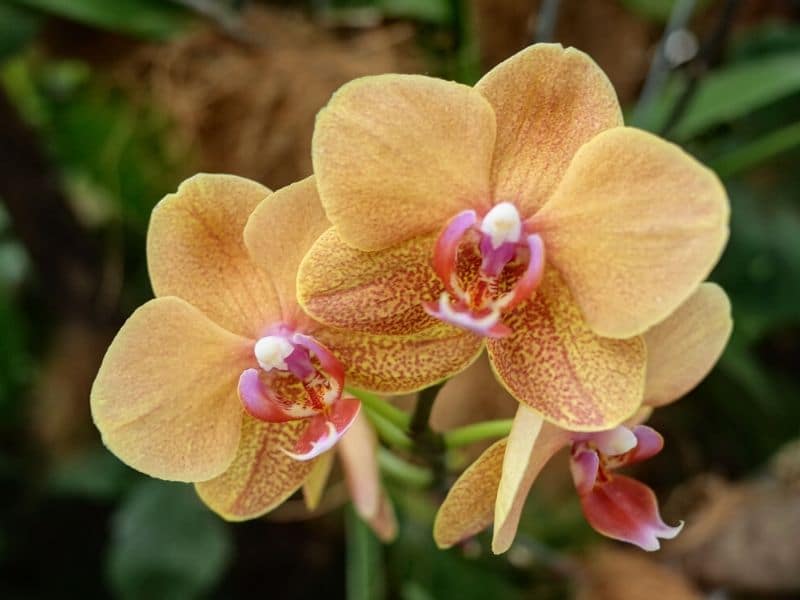
Orchid flowers are bilaterally symmetrical, which means that they have two identical halves if you divide them vertically.
Regardless of varying genus and species, all orchids share similar floral structures. Like other monocots, orchid flowers have two whorls. The outer whorl comprises three sepals, while the inner whorl consists of three petals, including two lateral petals and a medial petal called lip or labellum. The lip is often modified or enlarged and varies depending on the orchid type.
Also, an orchid lip may vary in form and color. It functions as a landing pad for pollinator insects like bees.
The sepals are the outermost part of an orchid flower. The sepal at the top part is called dorsal sepal, while the two sepals at the bottom are called lateral sepals.
Each orchid flower also has a column. It is the fleshy part of the center that holds the reproductive parts.
Most Popular Types of Orchids You Can Grow
Because of their diversity, choosing the right type of orchids for your home and garden could be overwhelming. This quick guide helps you identify the most popular types of orchid plants that you can grow as houseplants.
Cattleya
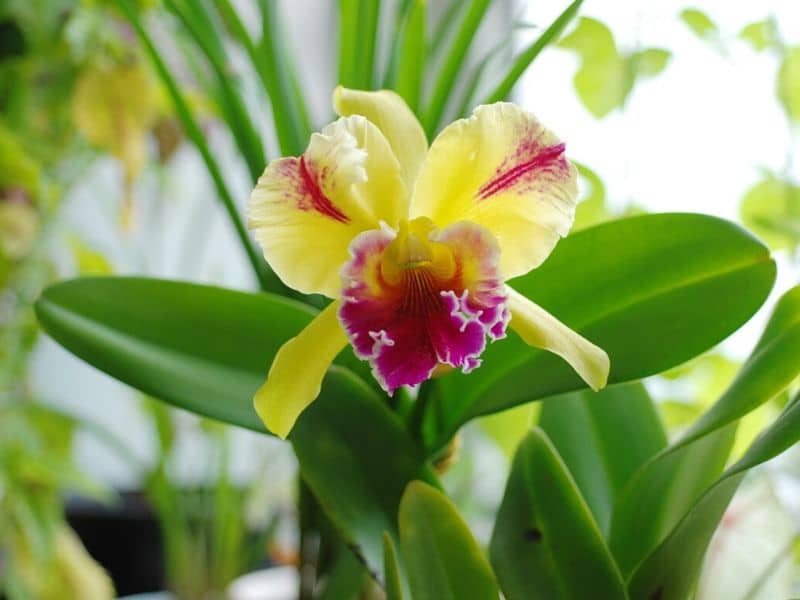
Scientific name: Cattleya spp.
Common names: Cattleya, Corsage Orchids, Old Corsage Orchids, Reinas Orchids, Queen of the Orchids
Growth Habit: Epiphytic orchid (sympodial) or lithophyte
Flowering: Spring/Fall (once a year)
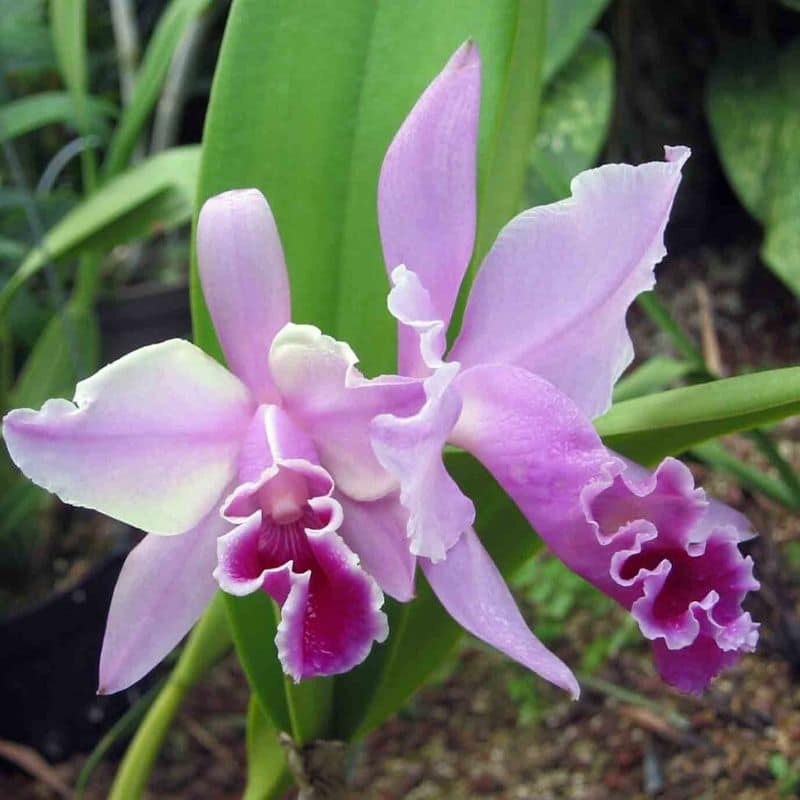
In the world of orchids, one of the most distinct types that many plant lovers and non-hobbyists collect is cattleya orchids. The popularity of this epiphytic orchid is undeniable, and one reason that we could look into is the size of its flowers.
Each cattleya flower measures around 5 to 8 inches across, which makes it one of the most prominent flowers in the orchid family. It has ruffled edges and large lips with a contrasting color in the center. The flowers typically last about 2 to 3 weeks, but some hybrids bloom up to 6 weeks (1). Some varieties are fragrant.
Aside from their prominent blooms, cattleya flowers are also distinguished for their labellum or lips that exhibit a different shape and color. Each flower stem can hold 2 to 10 flowers.
A cattleya plant has a pseudobulb that can grow up to 90 cm tall. One to three thick leaves and stems spring out of this pseudobulb.
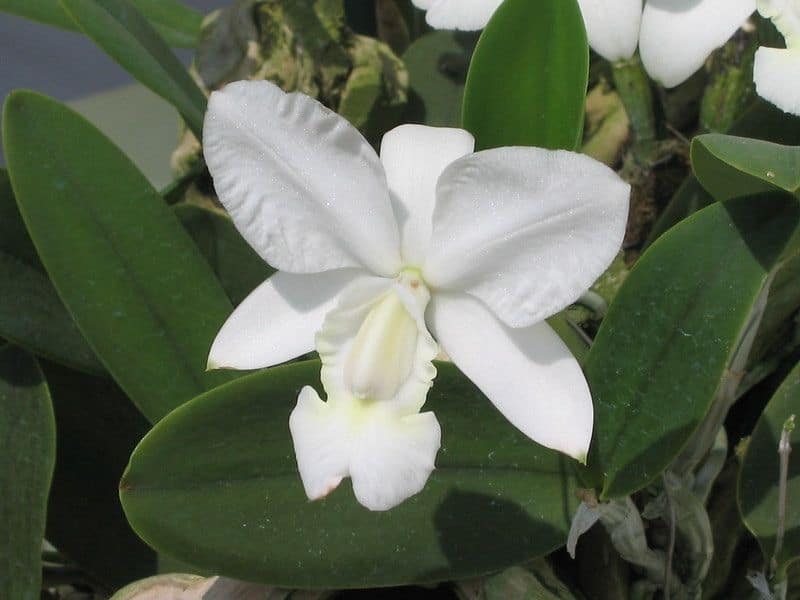
The name cattleya refers to an entire genus of plants under the Orchidaceae botanical family. It was named in 1824 by botanist John Lindley after English horticulturist William Cattley.
There are two primary groups of cattleya orchids: unifoliate and bifoliate cattleyas. The former group produces small to large flowers, while the latter produces smaller flowers but in more significant numbers.
Unifoliate cattleya orchids:
- Cattleya labiata
- Cattleya mossiae
- Cattleya mendellii
- Cattleya mossiae
- Cattleya warscewiczii
- Cattleya dowiana
- Cattleya percivaliana
Bifoliate cattleya orchids:
- Cattleya bicolor
- Cattleya amethystoglossa
- Cattleya elongata
- Cattleya harrisoniana
Dendrobium
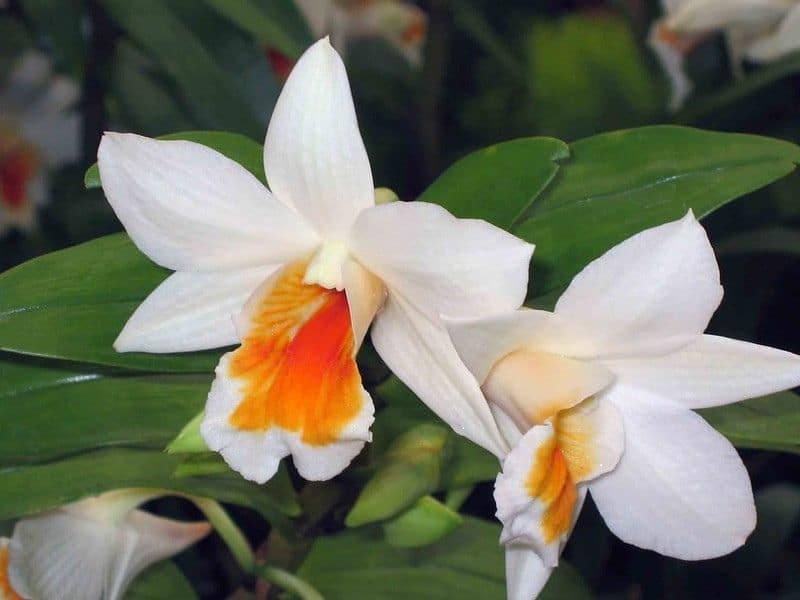
Scientific name: Dendrobium spp.
Common names: Dendrobium
Growth Habit: Most species are epiphytic (sympodial), but a few are terrestrial
Flowering: Fall – Winter
Dendrobium spp. is the second-largest genus in the Orchidaceae family with over 1,200 known species. The name dendrobium originated from the Greek words dendron or “tree” and bios or “life,” which collectively refers to the plant’s epiphytic habit.
Most dendrobium orchids present flowers that are lavender, white or a combination of the two (1). They are borne singly, in groups, or on arching spikes, depending on the species. The size of dendrobium flowers also vary. Some dendrobiums flaunt small blooms, while others have prominent ones.
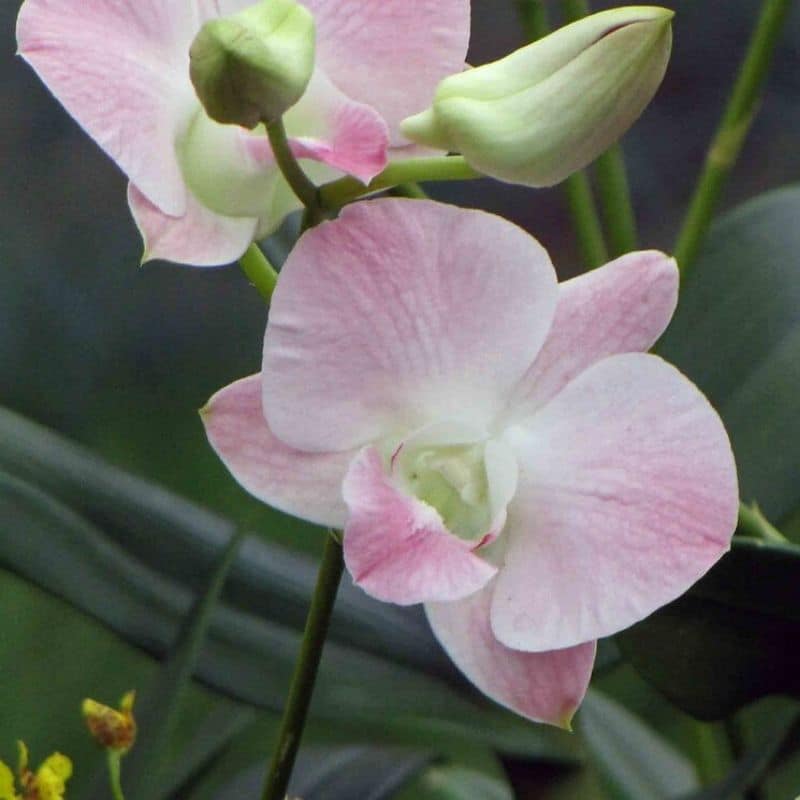
Though prized mainly for their attractive blooms, some species are also highly valued for their medicinal properties. One example is the Noble Dendrobium, D. nobile, which is a common plant in traditional Chinese medicine.
Dendrobiums are native to Australia, the Pacific Islands, and tropical and sub-tropical parts of Asia.
Best known Dendrobium orchids species:
- Noble Dendrobium (Dendrobium nobile)
- Unscented Dendrobium or Purple Rain Orchid (Dendrobium anosmum)
- Pink Rock Orchid (Dendrobium kingianum)
- Schuetze’s Dendrobium (Dendrobium schuetzei)
- Mrs. Sander’s Dendrobium (Dendrobium sanderae)
- Pigeon Orchids (Dendrobium crumenatum)
- Cucumber Orchids (Dendrobium cucumerinum)
- Bull Orchids (Dendrobium taurinum)
Phalaenopsis
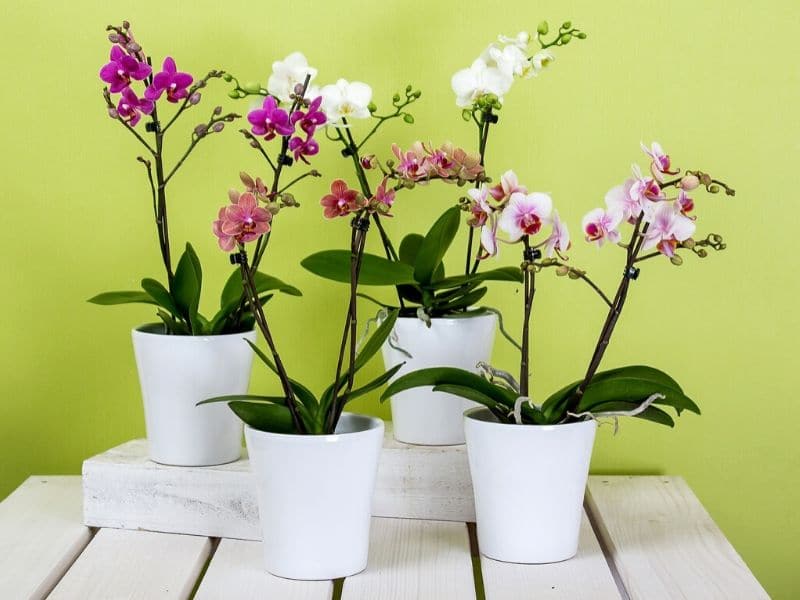
Scientific name: Phalaenopsis spp.
Common names: Phalaenopsis, Moth Orchids, Phals
Growth Habit: Epiphytic orchids (monopodial), sometimes lithophytes
Flowering: Fall – Spring (once a year)
If you’re about to get your first orchid but not sure which one to pick, Phalaenopsis orchids are always a good idea because they are one of the easiest orchids to grow.
Phalaenopsis orchids, or popularly referred to as Moth Orchids, are native to South Asia, Australia, and West Africa (3). They are known for their long, arching sprays or spikes of flowers that can hold up to 20 white, yellow, pink, red, or green flowers.
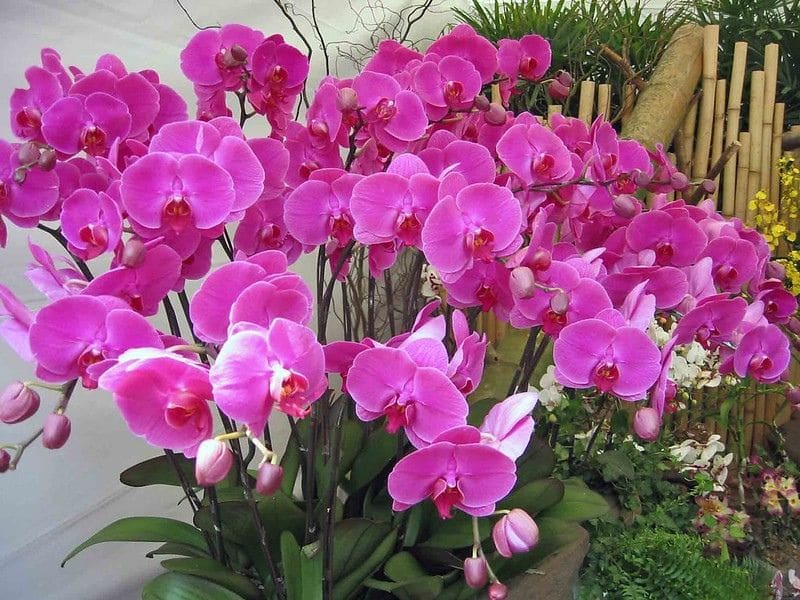
The flowers may also be spotted or striped, depending on the variety. Phalaenopsis flowers typically last up to four months (4). They are flat and wide with lips smaller than the petals.
Phalaenopsis flowers have two lateral petals, a central labellum or lip (modified petal), and three petal-like sepals. The stems are often short, while the roots are thick. The leaves are usually full, dark, flat, and arranged opposite each other.
This moth orchid is low-light plants. They thrive best under lower light conditions than most orchids and high humidity (3).
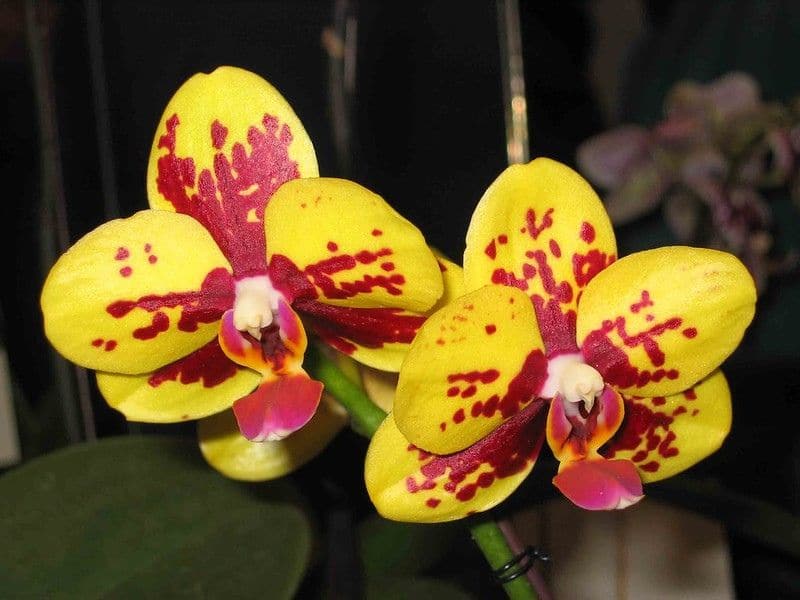
Best known Phalaenopsis orchids species:
- Moon orchid (Phalaenopsis amabilis)
- Aphrodite’s Phalaenopsis (Phalaenopsis aphrodite)
- Schiller’s Phalaenopsis (Phalaenopsis schilleriana)
- Violet Phalaenopsis (Phalaenopsis violacea)
- Horse Phalaenopsis (Phalaenopsis equestris)
Cymbidium
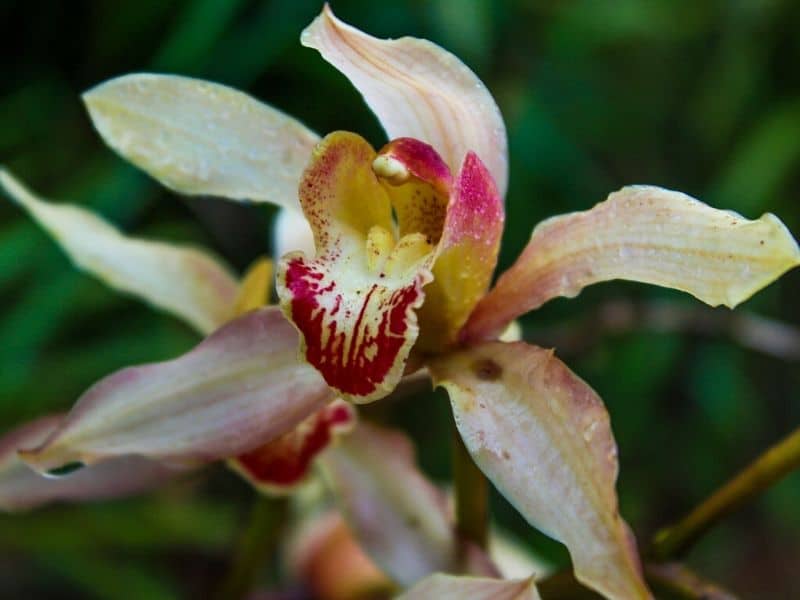
Scientific name: Cymbidium spp.
Common names: Cymbidium, Boat Orchids
Growth Habit: Epiphytic (sympodial) or terrestrial, depending on the species
Flowering: Fall – Winter
Cymbidium orchids, otherwise known as boat orchids, are well-recognized for their striking and long-lasting strays of showy blooms. Each spray holds 12 to 24 flowers of varying colors, including pink, yellow, green, and red, that are usually fragrant.
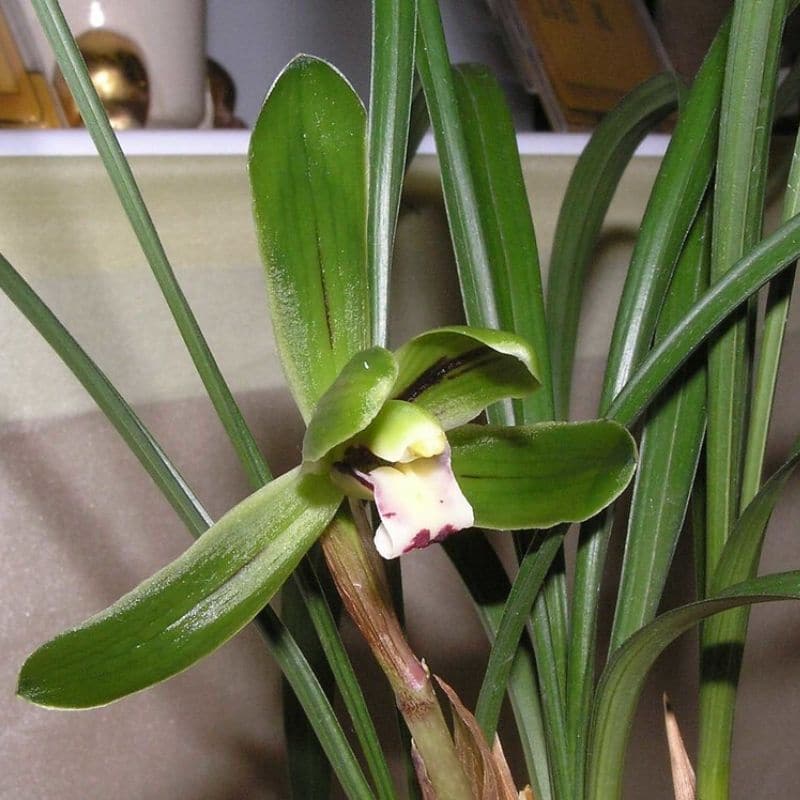
Generally, cymbidiums prefer cold temperatures to commence flowering. Once the blooms open, they can last for 8 to 10 weeks or longer, but they bloom only once. Cymbidium flowers are usually large and display a patterned lip at the center.
Epiphytic orchids in this genus have thick pseudobulbs, tall stems, and narrow, grassy leaves. Some species display variegated leaves. A mature plant reaches up to 4 ft in height.
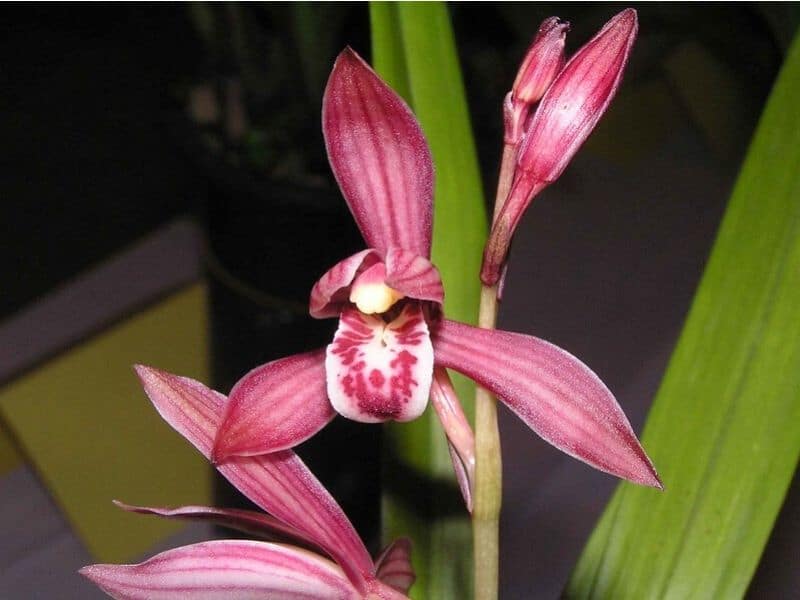
These orchids are native to parts of Asia, including the Philippines, Japan, China, and India, and Australia. The name “boat orchid” refers to the hollowness of the flower’s lip.
Best known Cymbidium orchids species:
- Noble Orchid (Cymbidium goeringii)
- Four-Season Orchid (Cymbidium ensifolium)
- Chinese Cymbidium (Cymbidium sinense)
- Cold Growing Cymbidium (Cymbidium kanran)
- Finlayson’s Cymbidium (Cymbidium finlaysonianum)
Paphiopedilum
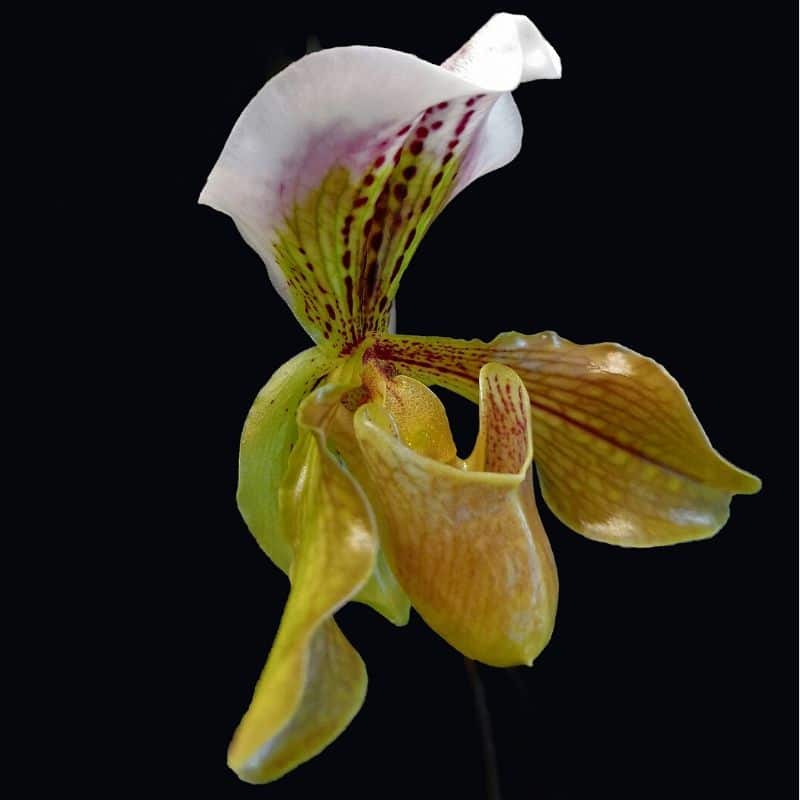
Scientific name: Paphiopedilum spp.
Common names: Paphiopedilum, Lady Slipper Orchids, Lady’s Slipper Orchids, Slipper Orchids, Venus Slipper Orchids, Paphs
Growth Habit: Terrestrial, semi-terrestrial, or epiphytic (sympodial), depending on the species
Flowering: Winter – Spring
Out of many types of orchids, Paphiopedilum orchids have one of the easily recognizable flowers. They are also known as lady slipper orchids, slipper orchids, or Venus slipper orchids because of their prominent lip that resembles a slipper (5). Also, the genus name Paphiopedilum originated from the Ancient Greek word pedilon, which translates to “slipper.”
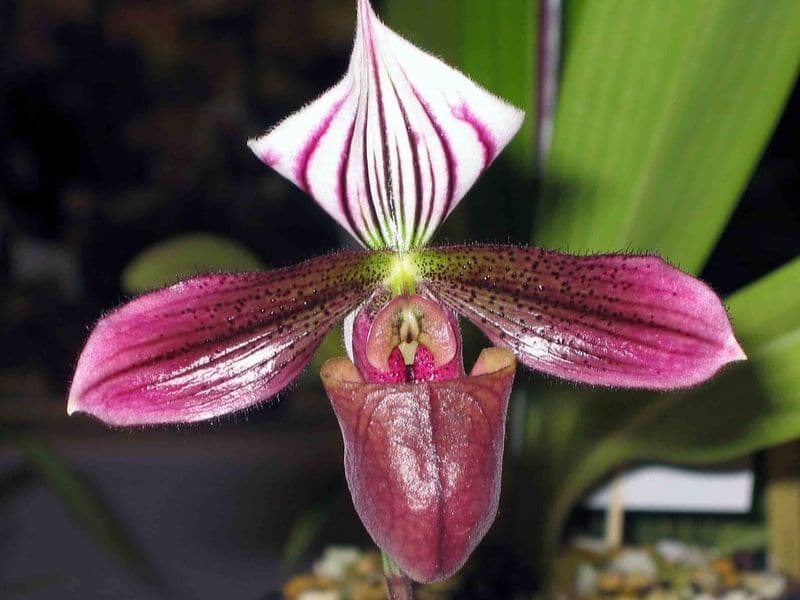
Paphs are native to Southeast Asia, Northern India, Southern China, and the Philippines that prefer low light like the Phalaenopsis orchid (4). They lack pseudobulbs. Thus they should never be allowed to dry out.
Paphiopedilum orchids are often marked with stripes or spots. They vary in color from white to red, pink, yellow, green, and brown. Each flower has a pouch-like lip with one large sepal at the top (4).
Paphiopedilum orchids are long-bloomers, with flowers, borne singly, or in a few-flowered raceme, that can last for more than 60 days. The leaves are elliptic-lanceolate and leathery (6).
Best known Paphiopedilum orchids species:
- Gold of Kinabalu Orchid (Paphiopedilum rothschildianum)
- Philippine Paphiopedilum (Paphiopedilum philippinense)
- Fowlie’s Paphiopedilum (Paphiopedilum fowliei)
- Short Haired Paphiopedilum (Paphiopedilum ciliolare)
- Pointed Tooth Paphiopedilum (Paphiopedilum acmodontum)
Oncidium
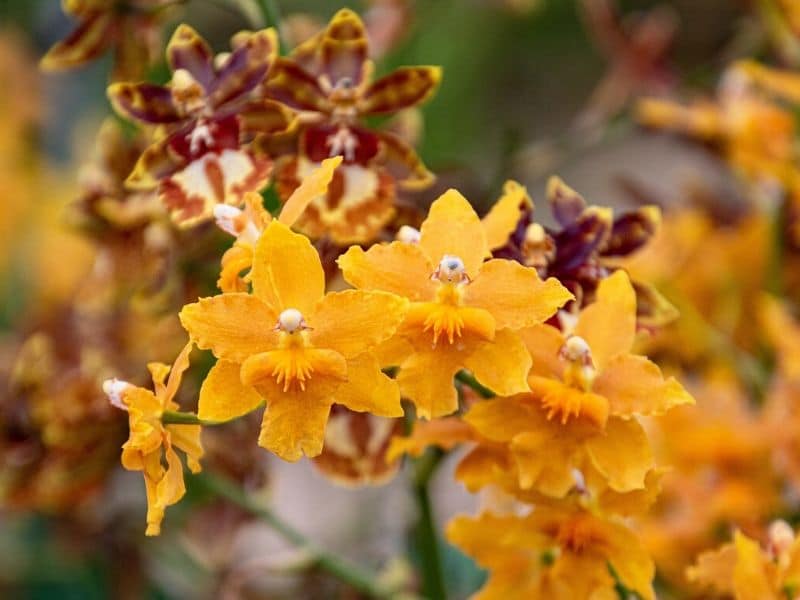
Scientific name: Oncidium spp.
Common names: Oncidium, Dancing Lady Orchids, Golden Shower Orchids, Spray Orchids, Bee Orchids, Tiger Orchids
Growth Habit: most are sympodial epiphytic, but some species are terrestrials or lithophytic
Flowering: Fall – Winter
Oncidium orchids are another florists and orchid-enthusiasts favorite because of their fascinating and proliferous blooms. Often referred to as dancing lady orchids or golden shower orchids, these plants produce many long and large spikes of smaller flowers (3).
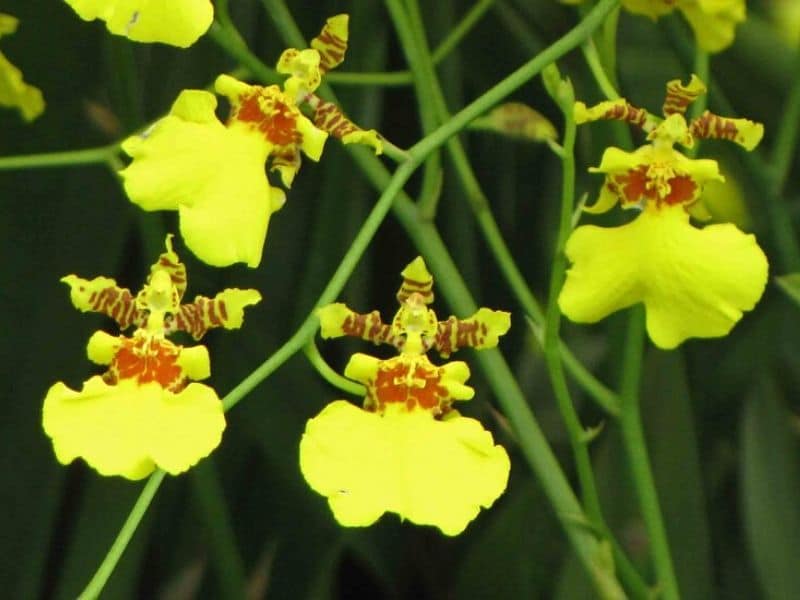
The genus name Oncidium originated from the Greek word onkos, which translates to “swelling” and refers to the flower’s prominent callus on the lip.
The flowers come in various colors that range from yellow to white, pink, and red. The petals and enormous lips often have ruffled edges. Flowers vary in size from 6 mm to 10 cm wide, depending on the species.
Oncidium orchids also feature pseudobulbs that produce several bracts with one to three leaves.
Best known Oncidium orchids species:
- Veined Oncidium (Oncidium varicosum)
- Burnt Spot Oncidium (Oncidium sphacelatum)
- Dancing Doll Orchid (Oncidium flexuosum)
- Hand Carrying Oncidium or Twinkle Oncidium (Oncidium cheirophorum)
Vanda
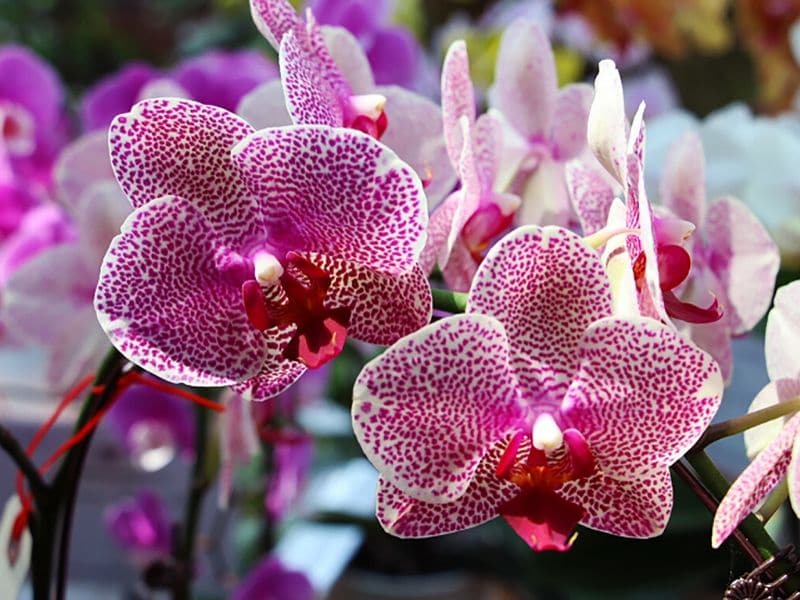
Scientific name: Vanda spp.
Common names: Vanda, Vanda Orchids, Singapore Orchids
Growth Habit: Monopodial epiphytic
Flowering: Spring – Fall
Vanda orchids are native to Southeast Asia (3) and widely recognized for their large and spectacular flowers in a wide spectrum of colors, including purple, white, yellow, brown, blue, and red. The flowers, which are long-lived and bloom more than once a year, are borne on spikes.
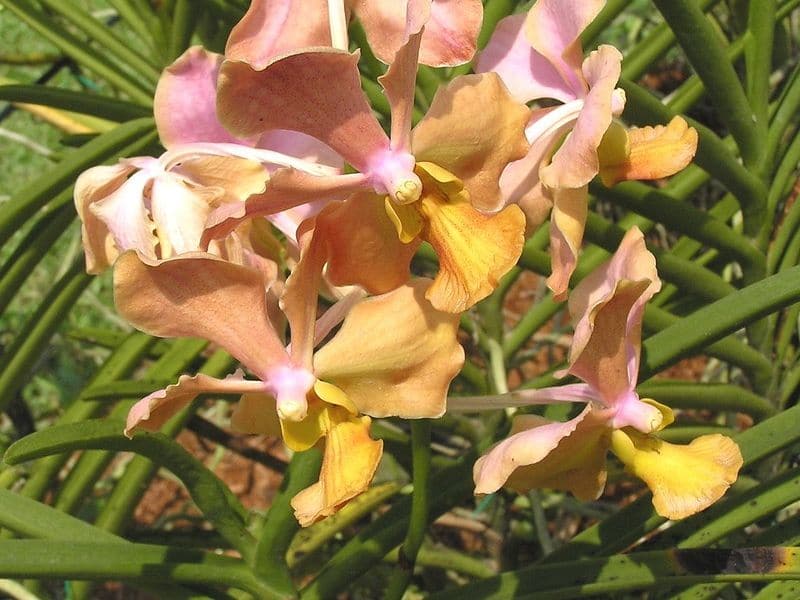
There are about 40 known species in the Vanda genus. However, because of their ornamental importance, thousands of hybrids of this orchid type have been developed worldwide.
Since vanda plants are monopodial orchids, they bear thick and upright stems with oppositely-arranged stiff leaves and aerial roots. Some of these orchids plants can grow up to 6 ft tall, but most species have a compact growth habit.
Vandas can further be classified into two groups depending on their leaves. The first group has strap-like leaves, which are leathery and thick, while the second group has “terete” leaves, which are cylindrical.
Best known Vanda orchids species:
- Blue Orchid (Vanda coerulea)
- Shy Blue Vanda (Vanda coerulescens)
- Checkered Vanda (Vanda tessellata)
- Waling-waling (Vanda sanderiana)
Encyclia
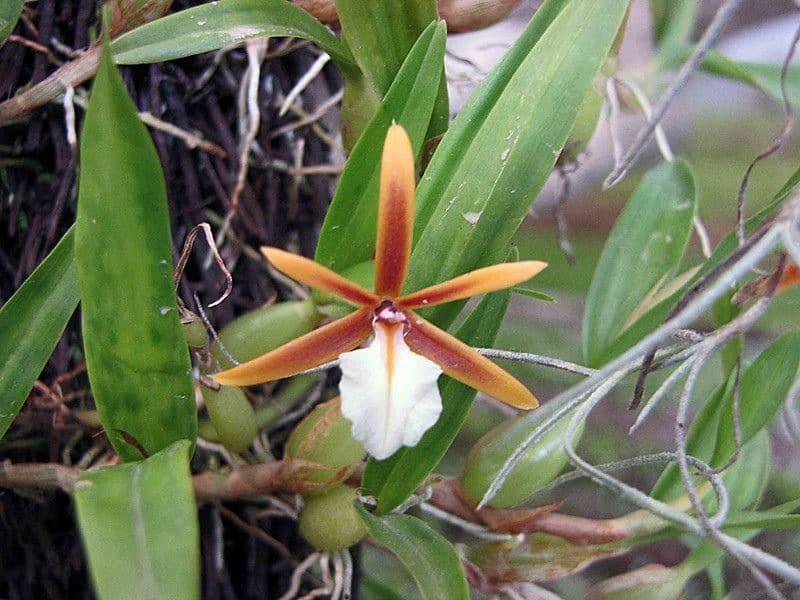
Scientific name: Encyclia spp.
Common names: Encyclia, Cockleshell Orchids, Butterfly Orchids, Upside-Down Orchids
Growth Habit: Sympodial epiphytic
Flowering: Winter – Spring
Native to the New World tropics, Encyclia orchids, or commonly known as cockleshell orchids, are epiphytic plants with a compact growth habit. They flaunt fragrant upside-down flowers that somehow resemble squids or octopuses.
The flowers of Encyclia are not as big and showy as other orchid flowers, but they are abundant. Each flower measures only about 4 cm in diameter and comes in a plethora of colors, including yellow, brown, green, purple, and pink.
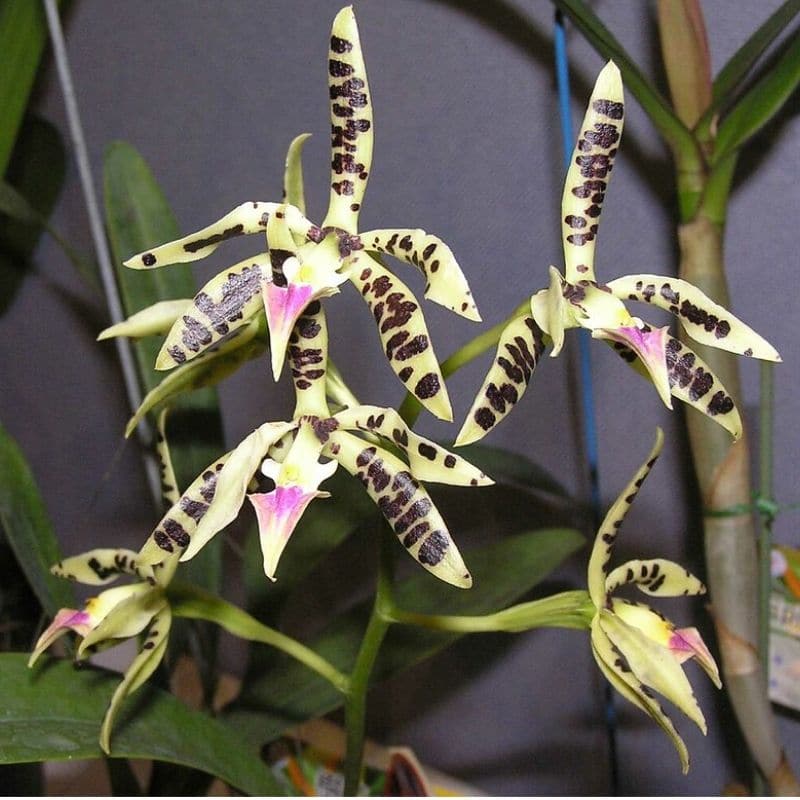
Another unique feature of these orchid flowers is their three-lobed lip that encircles the column. The genus name Encyclia originated from the Greek word enkyklein, which means “to surround or encircle” and refers to the orchid flower’s lip.
Encyclia orchid plants rounded, onion-shaped, and thick pseudobulbs from which two to three leaves emerge. A close relative of cattleya orchids, Encyclia require medium to bright light, intermediate (cool to warm) temperature, and 50% to 80% humidity.
There are currently about 147 to 188 known species in the Encyclia genus. The plants vary in size depending on the species, which can range from 2 inches to 2 ft in height.
Best known Encyclia orchids species:
- Winged Encyclia (Encyclia rioclarense)
- Bractescent Encyclia Orchid (Encyclia bractescens)
- Clamshell Orchid or Octopus Orchid (Encyclia cochleata)
- Lined Petal Orchid (Encyclia radiata)
- Florida Butterfly Orchid (Encyclia tampensis)
- Small-flowered Encyclia (Encyclia belizensis)
Epidendrum
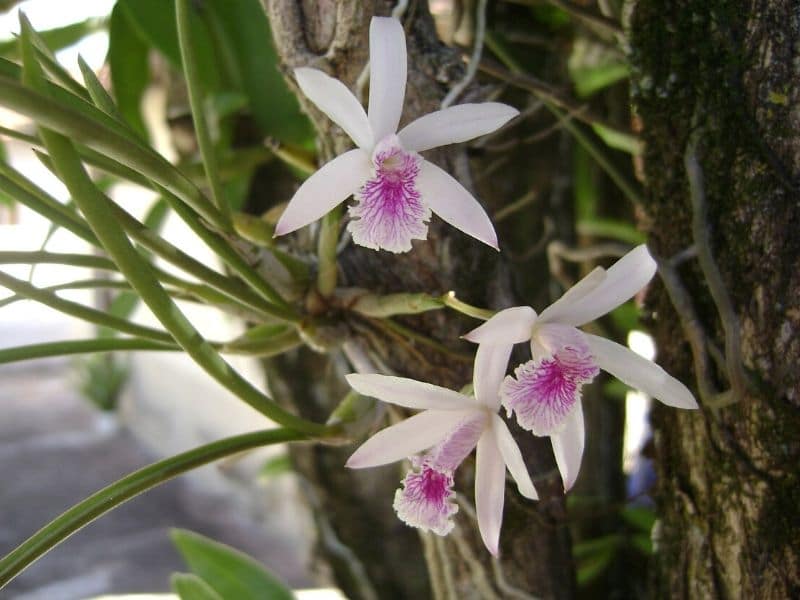
Scientific name: Epidendrum spp.
Common names: Epidendrum, Star Orchids, Reed Orchids, Crucifix Orchids
Growth Habit: Mostly monopodial epiphytic but a few species are terrestrial
Flowering: Fall – Spring
Epidendrum is a large genus of orchid plants with over 1,500 species that are close relatives of cattleyas. The name originated from the Greek words epi and dendron, which means “upon trees” and refers to the plant’s epiphytic growth habit.
Most epidendrum orchids have long and cane-like pseudobulbs and alternating leaves. On top of the pseudobulb emerges a long flower spike that holds a cluster of orchid flowers in varying colors, including red, white, yellow, and purple. Each flower typically grows up to about 1 inch in diameter (1).
Also called crucifix orchids, the flowers display a distinct three-lobed lip adnate to the column and with a close resemblance to a cross, hence the name. Each orchid flower cluster has about 30 to 40 small and long-lasting blooms. The leaves are leathery. This type of orchid produces keikis or baby plants after flowering.
Star orchids are native to tropics and subtropical regions of America.
Best known Epidendrum orchid species:
- Crucifix Orchid (Epidendrum ibaguense)
- Stamford’s Epidendrum (Epidendrum stamfordianum)
- Fire Star Orchid (Epidendrum radicans)
- Angel Orchid (Epidendrum secundum)
- Epidendrum phoeniceum
Vanilla
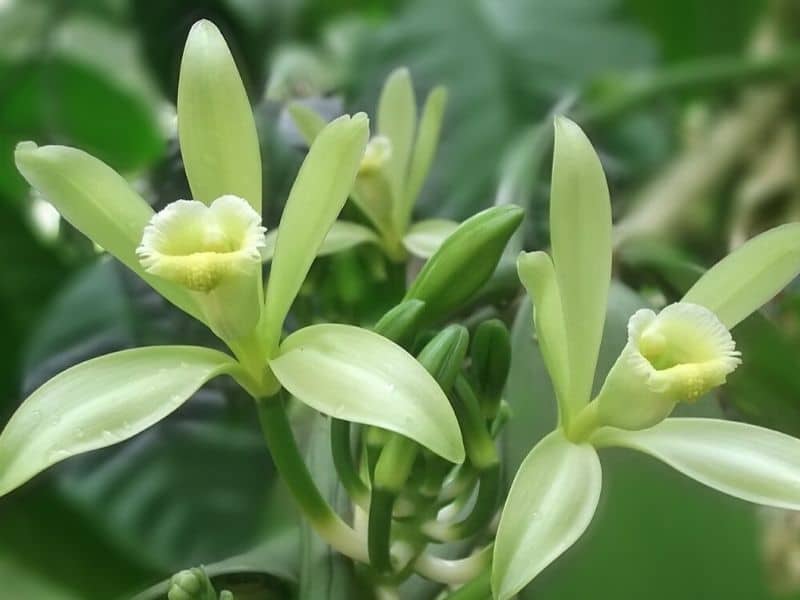
Scientific name: Vanilla spp.
Common names: Vanilla
Growth Habit: Monopodial epiphytic
Flowering: Spring – Summer
One of the most challenging orchids flowers to bring into bloom is vanilla orchids. Recognized for their scientific name Vanilla spp., plants in this genus produce an easy-to-grow succulent vine (3). They are native to Central America.
Vanilla planifolia, or the vanilla orchid, in particular, is a highly recognized orchid species because it produces beans from which vanilla flavoring is extracted.
Vanilla orchids, in general, are easy to grow. They require medium light, intermediate to warm temperature and frequent watering. The leaves are green and thick. The 5-inch flowers are full, yellow or yellowish-green, and emerge near the basal part of leaves. Each flower can last for only a day.
Best known Vanilla orchids species:
- Flat-Leaved Vanilla Orchid (Vanilla planifolia)
- Tahitian Vanilla (Vanilla tahitensis)
- Leafless Vanilla (Vanilla aphylla)
- Chamisso’s Vanilla (Vanilla chamissonis)
- Mexican Vanilla (Vanilla Mexicana)
List of Other Orchid Varieties You Can Explore
- Angraceum (Comet Orchid, Darwin’s Orchid, King of the Angraecums, Star of Bethlehem Orchid)
- Anguloa (Tulip Orchid)
- Arundina (Bamboo Orchid)
- Barkeria
- Bletilla (Chinese Ground Orchid)
- Brassavola (Lady-of-the-Night Orchid)
- Brassia (Spider Orchid)
- Bulbophyllum
- Catasetum
- Coelogyne
- Coryanthes (Bucket Orchid)
- Cycnoches
- Cypripedium
- Dendrophylax (Ghost Orchid)
- Disa (Pride of Table Mountain)
- Dracula
- Gongora
- Ludisia (Jewel Orchid)
- Laelia
- Lycaste
- Masdevallia
- Maxillaria (Tiger Orchid)
- Miltonia
- Miltoniopsis (Pansy Orchid)
- Mormodes
- Phaius (Nun Orchid)
- Odontoglossum
- Phragmipedium
- Pleione (Peacock Orchid)
- Pleurothallis
- Restrepia
- Sobralia
- Spathoglottis
- Stanhopea
- Zygopetalum
FAQs
What are the major types of orchids?
There are numerous types of orchids, but some major groups include Phalaenopsis, Cattleya, Dendrobium, Oncidium, and Paphiopedilum, among others.
What is the most special orchid?
The concept of the “most special” orchid is subjective and can vary based on individual preferences. However, some orchids are considered particularly rare or unique, such as the Ghost Orchid (Dendrophylax lindenii) known for its elusive nature and intricate beauty.
What are the 7 levels of classification for an orchid?
The seven levels of classification for an orchid, as with any organism, follow the taxonomic hierarchy: Kingdom, Division (or Phylum), Class, Order, Family, Genus, and Species. For example, a common orchid like the Moth Orchid (Phalaenopsis aphrodite) belongs to the Kingdom Plantae, Division Magnoliophyta, Class Liliopsida, Order Asparagales, Family Orchidaceae, Genus Phalaenopsis, and Species aphrodite.
Up Next: Orchid Flower Meaning and Symbolism
References
Reference List:
- Web.extension.illinois.edu. (2020). Growing Orchids. [online] Available at: https://web.extension.illinois.edu/hortihints/0204d.html
- Karyamsetty, Henry & Aluri, Jacob Solomon Raju. (2005). Terrestrial and epiphytic orchids of Eastern Ghats. EPTRI-ENVIS Newsletter. 11. 2-4.
- Aggie-horticulture.tamu.edu. (2020). Orchidaceae or Orchid Family. [online] Available at: https://aggie-horticulture.tamu.edu/syllabi/302/new/family/orchidaceae.html
- Extension.tennessee.edu. (2020). [online] Available at: https://extension.tennessee.edu/publications/Documents/PB1634.pdf
- Ndsu.edu. (2020). Paphiopedilum barbigerum – Val. [online] Available at: https://www.ndsu.edu/pubweb/chiwonlee/plsc211/student%20papers/articles03/val.eitreim/veitreim.htm
- De, L. & Rao, A & Rajeevan, P.K. & Dhiman, Sitaram & Srivastava, Manoj & Chhetri, Geetamani. (2019). MORPHOLOGICAL CHARACTERIZATION IN PAPHIOPEDILUM SPECIES. 2. 131-145.
Close
*Featured Photo by sweemingyoung/depositphotos

